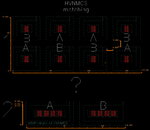mult
Junior Member level 1
Hi everybody!
My design uses huge devices which are high voltage devices.
The problem is that I doubt they should be matched in the same way as regular devices.
Does it really make sense to apply the same technique for matching (common centroid for example) when dimensions are so large.
Please see attached picture for reference.
case 1: common centroid layout of two HVNMOS
case 2: multi-finger structure for both devices
Could it be that the advantages of common centroid layout are offset by a significant increase of spacing between matching devices?
Which case (1 or 2) are preferable?

Thanks for your opinion!
My design uses huge devices which are high voltage devices.
The problem is that I doubt they should be matched in the same way as regular devices.
Does it really make sense to apply the same technique for matching (common centroid for example) when dimensions are so large.
Please see attached picture for reference.
case 1: common centroid layout of two HVNMOS
case 2: multi-finger structure for both devices
Could it be that the advantages of common centroid layout are offset by a significant increase of spacing between matching devices?
Which case (1 or 2) are preferable?

Thanks for your opinion!